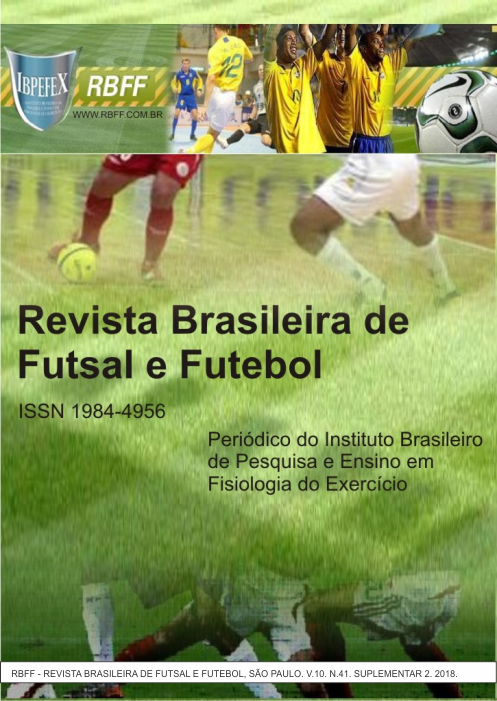Relationship of the players 'rotation with the injuries subjected to sub-20 athletes: a prospective study for 2 years
Abstract
The rotation can be seen as a maneuver to improve team performance and promote comprehensive training for all athletes. The objective of this study is to analyze the follow-up performed in two years (two seasons, 2016 and 2017) of an Under-20 team in relation to the rotation of athletes, performance achieved and number of injuries. They were followed 44 athletes in 2016 and 40 athletes in 2017 of an Under-20 team of an elite Brazilian team. The rotation was performed through the monitoring of the overviews of the matches of five different competitions (national and regional level), the performance achieved was based on the numbers of wins, draws and losses and the injuries were collected in the Medical Department of the institution. When comparing the competitions between the two years, it was possible to observe that they presented different characteristics, which influenced when we compare the season 2016 and 2017. Nevertheless, it was possible to conclude that the rotation can be an effective maneuver to maintain the performance of the athletes and generate better results for the teams, besides contributing to the formation of these young players.
References
-Alves, S. Rotatividade de jogadores no futebol. Uma relação <> do como treinar com o como <>. Dissertação de Mestrado. Faculdade de Desporto da Universidade do Porto. Porto. Portugal. 2007.
-Balsalobre-Fernández, C.; Glaister, M.; Lockey, R. A. The validity and reliability of an iPhone app for measuring vertical jump performance. Journal of Sports Sciences. Vol. 33. Num. 15. 2015. p. 1574-1579.
-Bangsbo,J. The physiology of soccer –with special reference to intenseintermittent exercise. Acta Physiologica Scandinavica. 1994.
-Fédération Internationale de Football Association. FIFA. FIFA Youth Football. Zurich. Swi. Galledia AG. 2016.
-Ganzer, V. R.; Ribeiro, Y. S.; Vecchio, F. B. Análise da aptidão física de jovens praticantes de futebol: efeitos do período de preparação e titularidade competitiva. Revista Brasileira de Futsal e Futebol. São Paulo. Vol. 8. Num. 29. 2016. p. 142-154. Disponível em: <http://www.rbff.com.br/index.php/rbff/article/view/402>
-Herdy, C.; Vale, R.; Silva, J.; Simão, R.; Novaes, J.; Lima, V.; Gonçalves, D.; Godoy, E.; Selfe, J.; Alkmim, R. Occurrence and type of sports injuries in elite young Brazilian soccer players. Archivos de Medicina del Deporte. Vol. 34. Num. 3. 2017. p. 140-144.
-McCall, A.; Carling, C.; Davison, M.; Nedelec, M.; Le Gall, F.; Berthoin, S.; Dupont G. Injury risk factors, screening tests and preventative strategies: a systematic review of the evidence that underpins the perceptions and practices of 44 football (soccer) teams from various premier leagues. British Journal of Sports Medicine. Vol. 49. Num. 9. 2015. p. 583–589.
-Neto, H. A.; Santos, E. V. O preço da bola: processo de formação de crianças do sport club internacional no contexto do futebol em rede. Revista Educação e Cultura Contemporânea. Vol. 14. Num. 34. 2016. p. 64-82.
-Pfirrmann, D.; Herbst, M.; Ingelfinger, P.; Simon, P.; Tug, S. Analysis of Injury Incidences in Male Professional Adult and Elite Youth Soccer Players: A Systematic Review. Journal of Athletic Training. Vol. 51. Num. 5. 2016. p. 410-424.
-Read, P.J.; Oliver J.L.; De Ste Croix, M. B.; Myer G.D.; Lloyd, R.S. The scientific foundations and associated injury risks of early soccer specialisation. Journal of Sports Sciences. Vol. 34. Num. 24. 2016. p. 2295-2302.
-Vaeyens, R.; Malina, R.M.; Janssens, M.; Van Renterghem, B.; Bourgois, J.; Vrijens, J.; Philippaerts, R.M. A multidisciplinar selection model for youth soccer: The Ghent Youth Soccer Project. British Journal of Sports Medicine. Vol. 40. Núm. 11. 2006. p. 928-934.
Authors who publish in this journal agree to the following terms:
- Authors retain the copyright and grant the journal the right of first publication, with work simultaneously licensed under the Creative Commons Attribution License BY-NC which allows the sharing of the work with acknowledgment of the authorship of the work and initial publication in this journal.
- Authors are authorized to enter into additional contracts separately for non-exclusive distribution of the version of the work published in this journal (eg, publishing in institutional repository or book chapter), with acknowledgment of authorship and initial publication in this journal.
- Authors are allowed and encouraged to post and distribute their work online (eg, in institutional repositories or on their personal page) at any point before or during the editorial process, as this can bring about productive change as well as increase impact and impact. citation of published work (See The Effect of Free Access).





